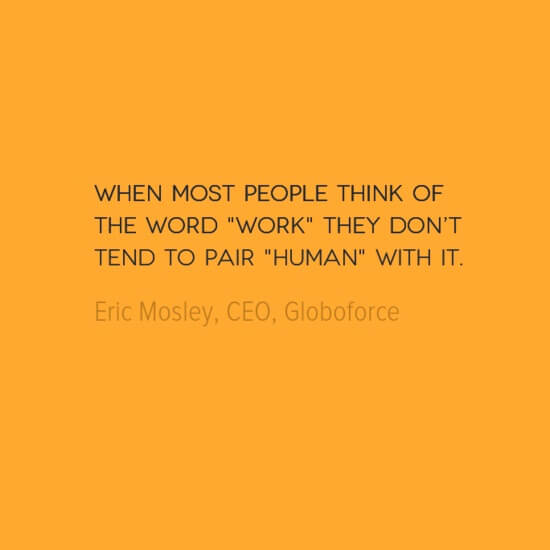“When most people think of the word ‘work’ they don’t tend to pair ‘human’ with it.”
How sad is that? But it’s true, especially when you consider the modern office’s use of technology. Technology does everything from scheduling bathroom breaks in a call center to monitoring employee performance reviews. And when technology is used to cull large amounts of data, poorly applied analytics dehumanize the work experience. That’s why it’s refreshing to hear a tech company CEO talk about bringing humanity back to the workplace. Eric Mosley is CEO of Globoforce, an HR software company that specializes in recognition.
This year, I’m attending Globoforce’s WorkHuman conference. I reached out to Eric to learn more about what it means to “work human” and how his company hopes to create a #workhuman movement. Here’s what he had to say about the importance of HR and business leaders creating a more human work culture:
What is a “workhuman” workplace?
A human workplace is one where all people—employees, leaders, HR management—are driven by bringing more humanity into the culture. At Globoforce, we believe that by turning moments of recognition into cultural movements and by spreading that message throughout the world, a more human workplace will result, empowering people to do the best work of their lives.
Is there a business case to be made for this approach?
Absolutely. The human experience also goes a long way in helping employees feel more assured in their jobs and apt to remain with a company. In fact, a new survey from Globoforce’s WorkHuman Research Institute finds that when employees believe leaders are striving to create a more human workplace, culture metrics improve. According to the report, when employees feel leaders care about a more human workplace, 89 percent said they believe their company cares about them as a person. And over 90 percent said they were motivated to work hard for their organization.
Why did your organization decide to devote an entire conference to the topic?
WorkHuman is more than a conference, it’s a movement. For Globoforce, the inspiration for WorkHuman comes from recognizing a need for a sweeping and profound change in the way employers manage talent. We have been seeing a disturbing trend involving employees being treated as thankless assets to organizational success, rather than valued members of a singular entity. Needless to say, this apathy toward employees’ overall well-being takes its toll on employees’ motivation and satisfaction, creating chasms in a company that can be detrimental to productivity and overall success. Through WorkHuman, we are attempting to change this.
Your company specializes in collecting and distributing data. In what ways can using data actually help create a more human corporate culture?
Research from our Institute shows that 21 percent of employees have never been recognized for their work. We also find that when employees are recognized for their work, 92 percent feel more appreciated, 86 percent feel happier at work and 85 percent are more satisfied with their job. [This data] demonstrates the need for social recognition and humanity in the workplace. When you can parse and compartmentalize this information in a visible, tangible way, you can see where challenges lie and then make concerted efforts to fix them.
Mosley finished up our interview with this thought:
Quantitative analysis has found its way into nearly every facet of the professional world—why not leverage its potential to improve the well-being of those driving the success of our businesses?
A truly honorable way to use analytics—for the well-being of employees. Works for me.
Want to join me at the WorkHuman conference? Register here. Use code WH16JV300 and you’ll get $300 off your registration fee.

This is such a wonderful echo of the powerful employee engagement work done at American Express years ago. Sadly, during the recession even the strong business case for what Eric is promoting (the numbers were very much the same back then) didn’t prevent employers from discarding the correlation between engaged employees and profit. I am delighted to see that this conference is trying to revive/reinvent that movement and bring it to life in today’s business environment.